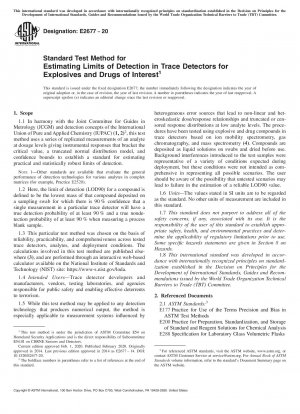ASTM E2677-20
Standard Test Method for Estimating Limits of Detection in Trace Detectors for Explosives and Drugs of Interest
- Standard No.
- ASTM E2677-20
- Release Date
- 2020
- Published By
- American Society for Testing and Materials (ASTM)
- Latest
- ASTM E2677-20
- Scope
- 1.1 In harmony with the Joint Committee for Guides in Metrology (JCGM) and detection concepts of the International Union of Pure and Applied Chemistry (IUPAC) (1, 2)2 , this test method uses a series of replicated measurements of an analyte at dosage levels giving instrumental responses that bracket the critical value, a truncated normal distribution model, and confidence bounds to establish a standard for estimating practical and statistically robust limits of detection. NOTE 1—Other standards are available that evaluate the general performance of detection technologies for various analytes in complex matrices (for example, Practice E2520). 1.2 Here, the limit of detection (LOD90) for a compound is defined to be the lowest mass of that compound deposited on a sampling swab for which there is 90 % confidence that a single measurement in a particular trace detector will have a true detection probability of at least 90 % and a true nondetection probability of at least 90 % when measuring a process blank sample. 1.3 This particular test method was chosen on the basis of reliability, practicability, and comprehensiveness across tested trace detectors, analytes, and deployment conditions. The calculations involved in this test method are published elsewhere (3), and are performed through an interactive web-based calculator available on the National Institute of Standards and Technology (NIST) site: https://www-s.nist.gov/loda. 1.4 Intended Users—Trace detector developers and manufacturers, vendors, testing laboratories, and agencies responsible for public safety and enabling effective deterrents to terrorism. 1.5 While this test method may be applied to any detection technology that produces numerical output, the method is especially applicable to measurement systems influenced by heterogeneous error sources that lead to non-linear and heteroskedastic dose/response relationships and truncated or censored response distributions at low analyte levels. The procedures have been tested using explosive and drug compounds in trace detectors based on ion mobility spectrometry, gas chromatography, and mass spectrometry (4). Compounds are deposited as liquid solutions on swabs and dried before use. Background interferences introduced to the test samples were representative of a variety of conditions expected during deployment, but these conditions were not intended as comprehensive in representing all possible scenarios. The user should be aware of the possibility that untested scenarios may lead to failure in the estimation of a reliable LOD90 value. 1.6 Units—The values stated in SI units are to be regarded as the standard. No other units of measurement are included in this standard. 1.7 This standard does not purport to address all of the safety concerns, if any, associated with its use. It is the responsibility of the user of this standard to establish appropriate safety, health, and environmental practices and determine the applicability of regulatory limitations prior to use. Some specific hazards statements are given in Section 8 on Hazards. 1.8 This international standard was developed in accordance with internationally recognized principles on standardization established in the Decision on Principles for the Development of International Standards, Guides and Recommendations issued by the World Trade Organization Technical Barriers to Trade (TBT) Committee.
ASTM E2677-20 Referenced Document
- ASTM E1154 Standard Specification for Piston or Plunger Operated Volumetric Apparatus
- ASTM E1323 Standard Guide for Evaluating Laboratory Measurement Practices and the Statistical Analysis of the Resulting Data
- ASTM E177 Standard Practice for Use of the Terms Precision and Bias in ASTM Test Methods
- ASTM E200 Standard Practice for Preparation, Standardization, and Storage of Standard and Reagent Solutions for Chemical Analysis
- ASTM E2520 Standard Practice for Measuring and Scoring Performance of Trace Explosive Chemical Detectors*, 2024-04-21 Update
- ASTM E2655 Standard Guide for Reporting Uncertainty of Test Results and Use of the Term Measurement Uncertainty in ASTM Test Methods
- ASTM E2771 Standard Terminology for Homeland Security Applications
- ASTM E288 Standard Specification for Laboratory Glass Volumetric Flasks
- ASTM E456 Standard Terminology for Relating to Quality and Statistics
- ASTM E542 Standard Practice for Gravimetric Calibration of Laboratory Volumetric Instruments*, 2022-01-01 Update
- ASTM E691 Standard Practice for Conducting an Interlaboratory Study to Determine the Precision of a Test Method
- ASTM E969 Standard Specification for Glass Volumetric (Transfer) Pipets
ASTM E2677-20 history
- 2020 ASTM E2677-20 Standard Test Method for Estimating Limits of Detection in Trace Detectors for Explosives and Drugs of Interest
- 2014 ASTM E2677-14 Standard Test Method for Determining Limits of Detection in Explosive Trace Detectors
